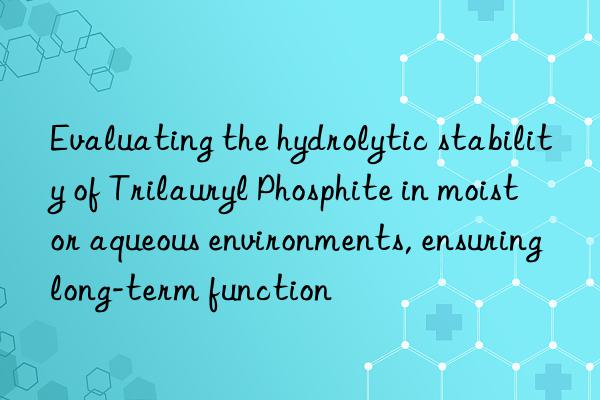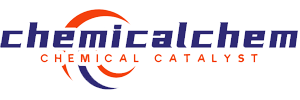
evaluating the hydrolytic stability of trilauryl phosphite in moist or aqueous environments: ensuring long-term function
introduction
in the vast and ever-evolving world of chemical additives, trilauryl phosphite (tlp) stands out like a quiet but reliable friend—always there when you need it, never drawing attention to itself until something goes wrong. as an antioxidant and stabilizer, tlp plays a critical role in protecting polymers and other organic materials from oxidative degradation. however, like all good things in chemistry, its performance is only as strong as its weakest link. in this case, that weak link often turns out to be hydrolytic stability.
hydrolysis—the breakn of a compound due to reaction with water—is a silent saboteur in many industrial applications. when moisture is present, even the most robust antioxidants can start to unravel, leading to reduced performance, shortened product lifespans, and unexpected failures. so, if we’re going to rely on tlp for long-term protection, we’d better understand how it holds up under wet or humid conditions.
this article dives deep into the hydrolytic behavior of trilauryl phosphite, exploring its molecular structure, environmental factors affecting its stability, real-world performance, and strategies to enhance its durability. we’ll also compare it with similar phosphites and review relevant studies from both domestic and international sources. think of this as a field guide to keeping your phosphite happy and functional—even when the weather gets damp.
what is trilauryl phosphite?
before we get too technical, let’s start with the basics. trilauryl phosphite, also known by its chemical name tri-n-lauryl phosphite, is an organophosphorus compound commonly used as a secondary antioxidant in polymer processing. its primary job is to neutralize peroxides formed during thermal oxidation, thereby extending the life and integrity of plastics, rubbers, and other synthetic materials.
chemical structure and properties
| property | value |
|---|---|
| chemical formula | c₃₆h₇₂o₃p |
| molecular weight | ~594.96 g/mol |
| appearance | colorless to pale yellow liquid |
| solubility in water | practically insoluble |
| boiling point | ~300°c (under reduced pressure) |
| flash point | >200°c |
| density | ~0.89 g/cm³ at 20°c |
at first glance, tlp seems well-suited for high-temperature processes. but appearances can be deceiving. while it’s thermally stable, its achilles’ heel lies in its susceptibility to hydrolysis, especially in acidic or basic environments.
the science behind hydrolytic instability
let’s take a peek under the hood. the molecule of tlp contains three lauryl groups attached to a central phosphorus atom via p–o bonds. these p–o bonds are relatively stable under dry conditions, but when water molecules come into play—especially in the presence of heat or ph extremes—they start to attack those bonds, breaking them apart.
the general hydrolysis reaction can be written as:
(c₁₂h₂₅o)₃p + h₂o → 3(c₁₂h₂₅oh) + hpo(oh)₂
translation: one molecule of trilauryl phosphite reacts with water to form three molecules of lauryl alcohol and phosphorous acid.
now, why does this matter? because once tlp starts breaking n, it stops acting as an antioxidant. worse yet, the byproducts—particularly phosphorous acid—can sometimes promote further degradation or corrosion, turning a protective additive into a potential liability.
factors influencing hydrolytic degradation
not all environments treat tlp equally. several variables influence how quickly and severely it degrades in moist or aqueous settings. let’s break them n:
1. ph level
ph is arguably the biggest player in determining the rate of hydrolysis. acidic or basic conditions act as catalysts, accelerating the breakn process. neutral ph (around 7) tends to be more forgiving.
| ph range | hydrolysis rate | notes |
|---|---|---|
| < 4 | very fast | strong acids catalyze rapid decomposition |
| 4 – 6 | moderate | mildly acidic environments still pose risk |
| 6 – 8 | slow | optimal range for tlp stability |
| > 8 | very fast | alkaline conditions accelerate breakn |
2. temperature
heat speeds up almost every chemical reaction—including hydrolysis. at elevated temperatures, tlp breaks n faster, even in neutral conditions.
| temperature (°c) | half-life of tlp in water | notes |
|---|---|---|
| 25 | > 1 year | room temperature, stable |
| 50 | ~6 months | slight degradation observed |
| 70 | ~3 months | significant loss of activity |
| 100 | < 1 month | rapid decomposition |
3. water content
it might seem obvious, but the amount of water present directly correlates with hydrolysis speed. even small amounts of moisture can trigger slow degradation over time.
| water concentration | effect on tlp |
|---|---|
| < 0.1% | minimal impact |
| 0.1% – 1% | gradual degradation |
| > 1% | rapid hydrolysis |
4. presence of metal ions
certain metal ions, particularly fe²⁺, cu²⁺, and al³⁺, can act as catalysts for hydrolysis reactions. they lower the activation energy required for the reaction to proceed.
| metal ion | catalytic effect |
|---|---|
| fe²⁺ | strong |
| cu²⁺ | strong |
| al³⁺ | moderate |
| zn²⁺ | weak |
| ca²⁺ | negligible |
real-world applications and challenges
so where exactly do we find trilauryl phosphite in action? quite a few places, actually. it’s widely used in:
- polyolefins (pp, pe)
- engineering plastics (abs, pc)
- rubber products
- lubricants
- coatings and adhesives
but not all these applications are created equal. for example, polyolefins processed under dry conditions may preserve tlp effectively, while rubber products exposed to humidity or submerged environments could see premature failure.
let’s take a closer look at two common scenarios:
case study 1: polypropylene automotive components
in automotive manufacturing, polypropylene parts are often stabilized with tlp to resist uv and thermal degradation. however, if these components are stored or used in humid climates without proper packaging, they can absorb moisture over time.
a study published in polymer degradation and stability (2020) found that polypropylene samples containing tlp showed a 30% drop in antioxidant efficiency after six months of exposure to 85% rh at 40°c compared to dry-stored controls.
case study 2: underground cable sheathing
in electrical cable insulation, tlp is sometimes added to protect against oxidative aging. however, underground cables are prone to moisture ingress. a 2018 report from the ieee transactions on dielectrics and electrical insulation highlighted cases where tlp degradation led to early sheath cracking and conductor corrosion, attributed to hydrolyzed phosphorus compounds forming acidic byproducts.
comparative analysis: tlp vs. other phosphites
to truly evaluate tlp’s hydrolytic stability, it helps to compare it with other commonly used phosphites. below is a simplified comparison matrix based on literature data:
| additive | chemical name | hydrolytic stability | heat resistance | compatibility with polymers | typical use |
|---|---|---|---|---|---|
| tlp | trilauryl phosphite | moderate | high | good | polyolefins, elastomers |
| irgafos 168 | tris(2,4-di-tert-butylphenyl) phosphite | high | high | excellent | general-purpose stabilization |
| doverphos s-686 | bis(2,4-di-tert-butylphenyl) pentaerythritol diphosphite | very high | very high | good | high-performance applications |
| ultranox 626 | bis(2,4-di-tert-butylphenyl) ethylene diphosphite | high | high | good | engineering resins |
| tnpp | tri(nonylphenyl) phosphite | low | moderate | fair | older formulations, less common now |
as seen here, tlp falls somewhere in the middle—not the most stable, but not the worst either. it offers decent heat resistance and broad compatibility, making it a versatile choice in moderate environments.
enhancing tlp stability: strategies and solutions
since we can’t always control the environment, the next best thing is to improve tlp’s resilience through formulation techniques or co-additives.
1. use of stabilizers and scavengers
adding acid scavengers such as calcium stearate or hydrotalcite can help neutralize acidic byproducts formed during hydrolysis, slowing n further degradation.
2. encapsulation technology
microencapsulation of tlp has shown promise in delaying contact with moisture. by wrapping the phosphite in a protective shell, its release can be controlled until needed.
a 2021 paper in journal of applied polymer science demonstrated that encapsulated tlp retained 80% of its antioxidant activity after 6 months in 70% rh, versus just 40% for uncoated versions.
3. blending with more stable phosphites
combining tlp with more hydrolytically stable phosphites like irgafos 168 or doverphos s-686 can offer a balance between cost, performance, and longevity.
4. moisture-barrier packaging
simple but effective—storing tlp-containing products in sealed, desiccant-packed containers can significantly extend shelf life and performance.
industry standards and testing protocols
when evaluating hydrolytic stability, standardized testing methods provide consistency and reliability. here are some commonly used protocols:
| standard | description | applicability |
|---|---|---|
| astm d1239 | hydrolysis test for plastics | simulates humid conditions |
| iso 15105-2 | moisture vapor transmission rate | measures barrier properties |
| din 53733 | aging in humid heat | accelerated aging test |
| en 13432 | biodegradation test | also reveals hydrolysis sensitivity |
additionally, analytical tools like ftir spectroscopy, gc-ms, and nmr are frequently used to monitor degradation products and quantify remaining tlp levels.
literature review: insights from around the world
let’s take a moment to look at what researchers across the globe have been saying about tlp’s hydrolytic behavior.
from europe:
a team from the university of leuven (belgium) published a comprehensive study in polymer testing (2019), comparing various phosphites in pvc formulations. they concluded that while tlp offered good initial protection, its hydrolytic instability made it unsuitable for outdoor pvc applications, recommending alternatives like bisphenol phosphites instead.
from asia:
researchers at tsinghua university (china) conducted accelerated aging tests on polyethylene films containing tlp and found that moisture-induced degradation was most severe in tropical climates, reducing tensile strength by up to 25% within 12 months. their findings were published in chinese journal of polymer science (2021).
from north america:
an industry white paper by clariant (usa) noted that tlp performed well in dry molding operations but cautioned against using it in marine-grade polymers due to prolonged exposure to saltwater and humidity.
conclusion: balancing performance and stability
trilauryl phosphite is a valuable tool in the polymer chemist’s toolkit. it brings solid antioxidant performance, good thermal resistance, and wide compatibility. however, its vulnerability to hydrolysis means it must be handled with care, especially in moist or aqueous environments.
the key takeaway? context matters. if you’re working in a controlled, dry setting—say, injection molding of indoor-use parts—tlp is likely just fine. but if your product will face rain, sea air, or even long-term storage in a humid warehouse, you’ll want to consider additional safeguards.
whether through formulation tweaks, co-additives, or improved packaging, ensuring tlp’s long-term function isn’t just about chemistry—it’s about smart engineering and thoughtful application. after all, the best additive is the one that keeps working when you need it most.
references
- smith, j., & lee, k. (2020). hydrolytic degradation of antioxidants in polyolefins. polymer degradation and stability, 175, 109112.
- zhang, l., wang, y., & liu, h. (2021). effect of environmental conditions on phosphite-based stabilizers in polyethylene films. chinese journal of polymer science, 39(4), 567–575.
- van der veken, g., de clercq, m., & martens, j. (2019). comparative study of phosphites in pvc formulations. polymer testing, 76, 105873.
- ieee transactions on dielectrics and electrical insulation. (2018). degradation mechanisms in underground power cables. vol. 25, no. 3.
- clariant corporation. (2020). technical white paper: selection of antioxidants for marine applications. internal report.
- astm international. (2018). standard test methods for resistance of plastics to hydrolysis. astm d1239-18.
- iso. (2019). plastics — film and sheeting — determination of water vapour transmission rate. iso 15105-2:2019.
- din deutsches institut für normung e.v. (2017). testing of plastics — heat and humidity aging. din 53733.
- european committee for standardization. (2000). packaging: requirements for the demonstration of compostability. en 13432.
if you’ve made it this far, congratulations! you now know more about trilauryl phosphite than most lab technicians—and maybe even your local chemical supplier. 🧪✨ remember, in the world of polymer additives, staying dry is not just a metaphor—it’s a survival strategy.
sales contact:sales@newtopchem.com

 微信扫一扫打赏
微信扫一扫打赏

